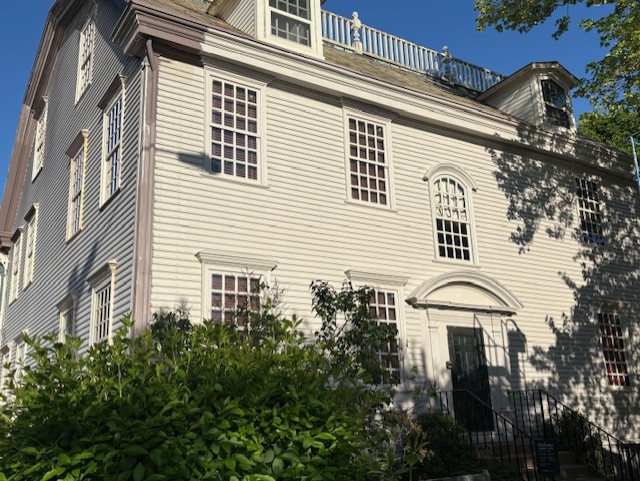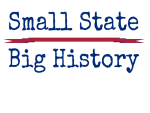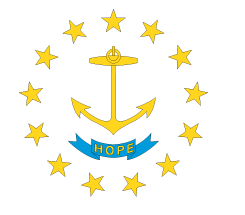In the mid eighteenth century in Newport, there were three men from the same family, contemporaries with almost the same name, all sons of governors.
Two, father and son, were each born to great wealth. The third, a close cousin of the others, lived a very different life. Yet these three men are frequently confused, with results that are embarrassing to history.
The father, Joseph Wanton, Sr. (1705-1780), the son of Governor William Wanton, would enter William’s thriving shipping business and at the age of 25 win a lucrative appointment as an official in the Newport customs house. It was a post that not only supplied a steady wage but presumably great lucre from Newport’s famous smuggling machine. In 1769 he was elected governor, and he presided delicately over the mounting conflict between his tiny colony and Great Britain.

Governor Joseph Wanton, Sr. served as governor of Rhode Island from May 1769 to November 1775 (Rhode Island State House)
His son, Joseph Wanton, Jr. (1732-1780), was born in Newport on January 14, 1732. The son studied Greek and Latin sufficiently well to gain admission to Harvard College at the age of sixteen. He entered the still prosperous family shipping firm after graduation and began a successful career in politics. He was elected to the town council at the age of 22 and served continuously for two decades. While still serving on the town council he was elected to the state assembly in the 1750s and was in and out of that office before being elected deputy governor in 1764 and 1767.[1]
Joseph Jr., who was described even by a friend as “foppish” and was fond of scarlet coats and frilly lace, used his largely honorific title of colonel in the local militia, but eschewed opportunities to lead his men in battle.
The cousin, Joseph G. Wanton (1720-1782), was born in Newport on November 5, 1720, the third son of Gideon Wanton, who served as Rhode Island’s treasurer and was twice elected governor for one-year terms in the 1740s.
Joseph G. lived a hardscrabble life, in contrast to his much-pampered relatives. He went to sea, became a ship captain, and entered the dirty and dangerous business of the slave trade, sailing to Africa, it appears, at least three times.[2] His only known foray into politics was to run, successfully, for sheriff of Newport County before the revolution. Captain Wanton, as he was known, would die destitute in Providence in 1782.[3]
These three men have been confused for at least a century and a half by historians of all types, from amateur experts to well-known writers to university professors. This article is an attempt to set the record straight.
The first of the family in New England, Edward Wanton (1629-1716), a shipbuilder, was an early convert to the Society of Friends and moved from Boston south to Scituate, Massachusetts. Perhaps due to persecution as Quakers, Edward’s sons William and John moved to Newport, and most of the rest of the family followed. William and John became famous in the colony and in England for their exploits against pirates and French privateers. Both became governors, and between them they dominated the politics of the colony for decades. William split with the Quakers and became an Anglican in order to marry outside the faith.
William’s son and grandson, both named Joseph, two of the three subjects of this article, would become as influential in Rhode Island politics as William and John. The merchant fleet belonging to their company, which did business as Joseph and William Wanton, was one of the biggest in Newport, and it was heavily involved in the trans-Atlantic slave trade. But the two Josephs would be best known for their unwitting roles in the American Revolution.

Joseph Wanton, Jr. purchased in Newport what is now called the Hunter House in 1757. He lived here with is first wife, Abigail Honeyman, and second wife, Sarah Brenton. He abandoned it in October 1779 when he departed with the British army for New York City (Timothy M. Phelps)
Joseph Wanton, Sr. married Mary Winthrop, who as the daughter and granddaughter of the governors of Connecticut and Massachusetts (both named John Winthrop) was Puritan royalty. Joseph Sr. had the misfortune to be elected governor of Rhode Island in 1769, the year after the British Army’s occupation of Boston, when Rhode Island was a hotbed of opposition to British tax policies. He tried for six years to straddle a line between the increasingly angry colony and its British masters. Contrary to some historical accounts, he was not a pro-British Tory, but neither was he an American Patriot. He received plaudits from Patriots for not taking stands that could have exposed the perpetrators of the burning of the British revenue cutter Gaspee. But when the Rhode Island General Assembly voted to raise an army of 1,500 men after the battles at Lexington and Concord in 1775, Wanton refused to authorize it, saying such a move would have terrible consequences. Even though he had just been reelected, the assembly removed him from office.[4] When the British military seized Newport in December 1776 and occupied it for the next three years, Wanton remained in Newport. Wanton remained in Newport after the British departed Newport, in October 1779, and died there in 1780.[5]
In contrast to his father’s middle-of-the-road loyalties, Joseph Jr. was a Tory through-and-through. His second wife was Sarah Brenton, daughter of noted Newport Tory Jahleel Brenton. In late 1775 Joseph Jr. refused to sign any oath of loyalty to the revolution, earning himself a few days of detention. The following summer he was escorted out of Newport and confined to his farm in Jamestown. But after the British invasion of Newport Wanton was there to welcome the British troops, and entertained them at his Water Street mansion, now known as Hunter House. He was briefly put in charge of the Tory militia in October 1777. When the British withdrew from Newport two years later, Wanton dared not stay. He fled with the British to New York, where he died in exile in 1780.[6]
The two wealthy Wantons, Governor Joseph and Deputy Governor Joseph Jr., are frequently cited as being captains of slave ships. In fact, of the three, only Captain Joseph G. Wanton is known to have ever set sail as master of a slave ship, or likely, any ship. His two cousins were far too rich, and far too occupied in their mercantile business and state and local government in Rhode Island, to stoop to the rigors and the hazards of the sea, though their firm owned an entire fleet of merchant ships, including slavers. (If confirmation were needed, only one of the three Josephs, Joseph G., was admitted to the Newport Fellowship Club, the mutual aid society for sea captains later called the Marine Society.)[7]
The Wantons were a large, powerful family. At the time of the American Revolution there were twenty Wanton households in Newport.[8] Five Wantons, siblings or close cousins, became governor or deputy governor of Rhode Island within just four decades. There may have been five or more Joseph Wantons living in Rhode Island at the same time, including the first Joseph Wanton (1664-1754), a Quaker shipbuilder from Tiverton, who was the older brother to governors William and John. It is little wonder that people became confused.
Unfortunately, the confusion begins with the most complete study of the Wanton family, John Russell Bartlett’s History of the Wanton Family of Newport, Rhode Island.[9] Bartlett, a Providence and New York bookseller, librarian, businessman and Rhode Island Secretary of State, assigned both Joseph G. Wanton and Joseph Wanton, Jr., the same incorrect birth year, 1730, an error that would be fatal for historians to come. At least Bartlett warned that the three Josephs had often been confused, a warning few heeded. But Barlett’s mistake, giving the two younger Joseph Wantons the same birth year, is widely reproduced.
Other seemingly authoritative nineteenth century sources confuse the different Wantons as well. Appletons’ Cyclopaedia of American Biography[10] conflates the governor with his son the deputy governor. Vital Records of Rhode Island 1636-1850 by James Arnold, published in 1891, confuses Joseph G. Wanton with his brother, John G. Wanton.
The confusion among modern scholars goes back to Elizabeth Donnan, the most prominent of twentieth century researchers of the American slave trade, whose work is universally respected and continues to be a basis for new scholarship. In her 1932 volume Documents Illustrative of the History of the Slave Trade to America, Donnan published a 1758 deposition from “Joseph Wanton” concerning his trip to Africa in command of the snow King of Prussia.[11] Donnan, in a footnote, identifies this Wanton as the former Rhode Island governor who served from 1769 to 1775. But that is not the case because the Joseph Wanton deposition begins “I, Joseph Wanton, being one of the people called Quakers….” Governor Joseph Wanton, Sr., (1705-1780), was from the Anglican side of the Wanton family. He was no Quaker. But Joseph G. Wanton (1720-1781), who unfortunately did not always use his middle initial, was a Quaker. New England Quakers did not forbid participation in the slave trade until 1760, and it took some time for the ban to be fully effective.
The problems do not stop there. Governor Joseph Wanton (1705-1780) and his equally prominent son, “Colonel” Joseph Wanton, Jr., (1732-1780), are frequently confused with each other: They had the same name, they both had the word governor in their titles, they both died in the same year, and they worked together in the same prominent merchant company, Joseph & William Wanton, with Joseph Jr’s brother William.
Following Donnan, other prominent writers and historians of the modern age succumbed. Bertram Lippincott, the eminent publisher and writer who was himself a Wanton descendant, asserted in his beautifully written popular history of Rhode Island, Indians, Privateers and High Society,[12] that Governor Joseph Wanton “was formerly the captain of a slave ship,”[13] and that he was a Quaker.[14] He was neither. Rockwell Stensrud, in his authoritative history, Newport, A Lively Experiment,[15] three times confuses Deputy Governor Joseph Wanton, Jr., with his father, the governor.[16] Charles Rappleye, in his book on the Brown brothers of Providence, Sons of Providence,[17] says that Governor Joseph Wanton’s son Joseph Jr. offered his services as a slave captain to the Browns[18]—but the written offer was signed Joseph G. Wanton.[19]

Sea Captains Carousing in Surinam (ca. 1755) by John Greenwood. A Wikipedia entry on the History of Rhode Island incorrectly states that in the painting, Governor Joseph Wanton is shown “being doused with punch and vomit” (St. Louis Art Museum)
Most recently, Sean M. Kelley’s scholarly book on the American slave trade, American Slavers,[20] reports that one of Newport’s top slave ship owners, Joseph Wanton, was “on record as having personally skippered a Guineaman.”[21] He is thinking of Joseph G. Wanton, who was primarily a ship captain and never more than a small part owner of a slaving vessel. (Kelley also promulgates another error that is just lately making the rounds, that prominent Newport slave trader Francis Malbone was the son of even bigger slave trader Godfrey Malbone. The exact relationship between the two Malbones is not known, but Francis was either a cousin, or more likely, a nephew of Godfrey, who had only two sons who lived full lives, Godfrey Jr., and John. (By the way, contrary to popular belief, there is no evidence that Godfrey Jr. or John Malbone, who did business as Godrey and John Malbone, participated in the trans-Atlantic slave trade. Though there is evidence they did consider it, Godfrey Jr. and to a lesser extent John were impecunious, and did not have the funds for such an expensive venture).
The befuddlement over the Wantons extends to the arts as well. Perhaps the most iconic image used to portray the prolific Rhode Island slave trade is the famous painting, Sea Captains Carousing in Surinam, by John Greenwood, despite the fact that Rhode Island sea captains seldom travelled to Surinam to buy or sell people into slavery.[22] To be sure, people likely to have been in bondage in Surinam are depicted as serving the drunken sea captains, many of whom may have been in the slave trade elsewhere. But in scholarship (see the website of the National Museum of African American History and Culture), and the popular imagination, the captains in Surinam and the slave trade have been conflated. The Rhode Island trade with Surinam, a major sugar and slave plantation economy controlled by the Dutch, consisted primarily of selling New England salted fish and other foodstuffs in exchange for sugar and molasses.
Even more problematic for scholarship are the spurious identifications of the depicted sea captains in papers written about the painting, notably Robert W. Kenny’s Sea Captains Carousing in Surinam, published in volume 36 in Rhode Island History in November 1977. The painter did not identify his subjects (if, in fact, they were meant to be real people). Members of the family that owned the painting for centuries have speculated through family “tradition” who some of the figures were meant to be, with others “identified” through pure conjecture by authors like Kenny.
Kenny discourses on the Wantons at some length, confusing at one point Governor Wanton with his son the deputy governor, and concluding erroneously that one of the captains, portrayed as passed out while others carouse around him, was Joseph Wanton, Sr. He seems unaware of the existence of Joseph G. Wanton.
The list of published “scholarly works” and magazine and journal articles that confuse the members of the Wanton family is far too large to print here.
(So as not to confuse the reader further, I will not discuss Newport Wantons named Peter, Edward and Zebulon who were captains in the slave trade but have the saving virtue of not being named Joseph).
Turning to modern media, the Wikipedia entry for Governor Joseph Wanton as of this publication perpetuates the myth of his appearance in the Surinam painting as well as Donnan’s mistake about his ship being seized off the coast of Africa by the French.[23]
The distinction between the three best-known Joseph Wantons is of historical importance, not moral. The Josephs who were governor and deputy governor may not have captained a slave ship, but their family firm financed a minimum of fifteen slave voyages between 1762 and 1775. Given the paucity of early records, they likely financed even more. They carried at least 1,800 innocent African captives off the coast of Africa.[24] But Governor Joseph and Deputy Governor Joseph Jr. were important figures in Rhode Island history, particularly around the revolution. They ought not be confused with their cousin of lesser significance.
Since the list of offenders amongst writers about Rhode Island history is so long, they are all hereby pardoned for what is nearly a universal error. But hereafter, dear writer, you are on notice.
[The author wishes to thank the Bertram Lippincott of the Newport Historical Society for his considerable research on the Wanton family in aid of this project.]Notes
[1] Edward B. Welch, “Joseph Wanton, Junior, An Eighteenth Century Newport Tragedy,” Newport History, Vol. 61, Part 1 (1988), 18-35. [2] See the Trans-Atlantic Slave Trade Database at www.slavevoyages.org. [3] Newport Mercury, March 19, 1792. [4] Welch, “Joseph Wanton,” 30. [5] See “Joseph Wanton,” Wikipedia, https://en.wikipedia.org/wiki/Joseph_Wanton. [6] Welch, “Joseph Wanton,” 34. [7] Marine Society Papers, Boxes 1,2 and 3, Newport Historical Society, Newport, Rhode Island. [8] John J. Slocum, The Darker Side of the Moon (Redwood Library and Athenaeum, 1976), 132. [9] John Russell Bartlett, History of the Wanton Family of Newport, Rhode Island (Providence: Sidney S. Rider, 1878). [10] James Grant Wilson, ed., Appletons’ Cyclopaedia of American Biography, Vol. 7 (New York: D. Appleton and Co., 1889), 346-47. [11] Elizabeth Donnan, Documents Illustrative of the History of the Slave Trade to America, Vol. 3 (Washington, D.C.: Carnegie Institution of Washington, 1932), 183. [12] Bertram Lippincott, Indians, Privateers and High Society (Philadelphia and New York: J.B. Lippincott Company, 1961), 123. The author of this book was the grandfather of the man by the same name, who has been a widely respected librarian at the Newport Historical Society for many years. [13] Ibid., 123. [14] Ibid., 77. [15] Rockwell Stensrud, Newport, A Lively Experiment, 1639-1969 (Newport: Redwood Library and Athenaeum, 2006). [16] Ibid., 187, 190 and 201. [17] Charles Rappleye, Sons of Providence, The Brown Brothers, the Slave Trade and the American Revolution (New York, NY: Simon & Schuster, 2006). [18] Ibid., 59. [19] Joseph Wanton to Nicholas Brown & Co, August 4, 1764, Brown University Library, at https://repository.library.brown.edu/studio/item/bdr:303401/. [20] Sean M. Kelley, American Slavers: Merchants, Mariners, and the Transatlantic Commerce in Captives, 1644-1865 (New Haven, CT: Yale University Press, 2023). [22] See Trans-Atlantic Slave Trade Database at www.slavevoyages.org. [23] See “Joseph Wanton,” Wikipedia, https://en.wikipedia.org/wiki/Joseph_Wanton. [24] See The Trans-Atlantic Slave Trade Database, at www.slavevoyages.org.























